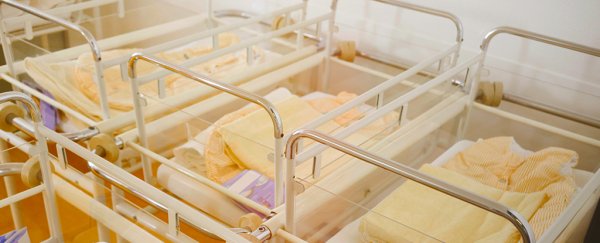Just a few months after the US Centers for Disease Control and Prevention (CDC) released a report detailing the nation's dropping fertility rate, the agency has now published preliminary data on the actual number of children born in 2018.
Officially speaking, 3,788,235 babies entered the world as US citizens last year. That might sound like a big number, but it's down 2 percent on 2017's total, continuing a trend that's bound to affect the nation's future in more ways than one.
The figures shouldn't come as a surprise to anybody who's been following news on the decline over recent years. It's the fourth year in a row that birth figures have confirmed dipping fertility, bringing the birth rate to its lowest point in 32 years.
In January a CDC report on total fertility rates across different US demographics in 2017 also estimated an average drop of 2 percent, to a predicted 1,765.5 births for every 1,000 women.
For births to replace deaths across the country, that number should be somewhere over 2,100, a cut-off that hasn't been met for at least a decade.
It's news everybody will have a different opinion on.
Political leaders like House Speaker Paul D. Ryan (R-Wis) want Americans to have more babies, potentially out of concern over shifts in the balance of demographics or the economic challenges it poses.
Others might be grateful for any glimmer of a drop in population growth, looking forward to potential environmental benefits and fairer socioeconomics.
While the report doesn't speculate on any causes for the ongoing decline, a breakdown of the numbers provides some clues.
The report shows a rise in births among older demographics, even as the number of mothers aged between 15 and 34 continues to drop.
In fact, the number of births to mothers over the age of 45 jumped a whole 3 percent last year.
There's no doubt a variety of contributing factors, among them the likelihood that a number of women are waiting longer to fall pregnant for personal and economic reasons.
Improvements in assisted reproductive technologies are also helping more women have children well into their forties.
Perhaps as a consequence of this bias towards older mothers, pre-term births were also slightly up. For some demographics, this is a serious concern.
"Our unequal society has negative consequences for health," says Stacey D. Stewart, CEO of the mothers and infants advocacy group, March of Dimes.
"Persistent inequities in access to quality health care in our country play a role in driving up the preterm birth rate."
If the figures reflect a temporary hold-off as families delay baby-making for a decade or so, we might well see fertility rates bounce back in coming years. Economic incentives, such as parental leave benefits, better healthcare systems, and a focus on reducing career risks for mothers, might even help put the brakes on the slide sooner.
But some aren't just pressing pause on pregnancy. A number of people around the world are abstaining from the whole reproductive process altogether, out of fears over an unsustainable future in a world affected by climate change.
Even among those who are keen to continue their family lineage, there are mysterious environmental effects that could quite literally be putting the fertility of every man and his dog at risk by reducing the quality of their sperm.
If people were actually having sex like they used to – which they're not – this might be a significant issue all on its own.
The US is far from alone in any of this. In fact, after decades of envisioning a future Earth packed cheek-to-cheek with humans, some experts think it's possible our global population could max out at just under 9 billion in the next few decades.
The face of America, and indeed the world, is set to change in coming years as some populations shrink and others migrate.
Regardless of the long term projections, the CDC's figures are sure to be used across the political spectrum to argue in favour of their preferred future vision.
A pdf of the CDC report can be downloaded here.
